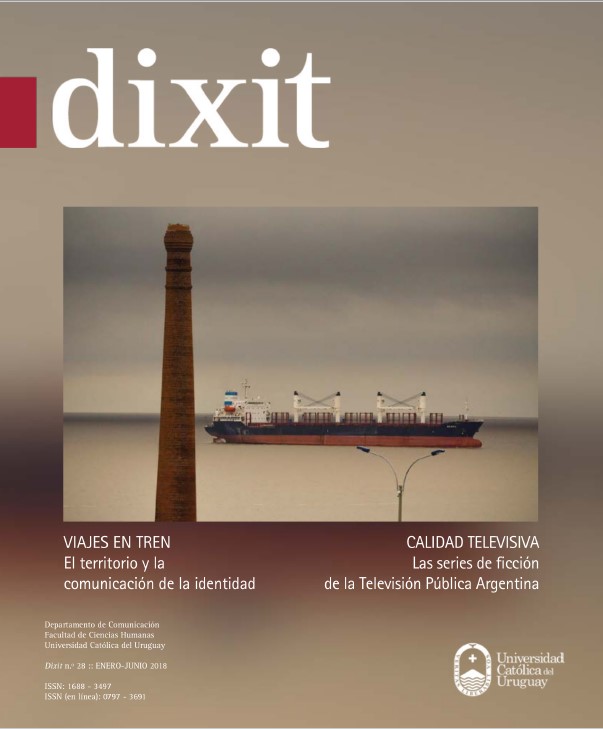Train Travel: The Territory and the Communication of Identity
DOI:
https://doi.org/10.22235/d.v0i28.1577Keywords:
cultural communication, heritage, New Zealand, sense of place, tourist trainsAbstract
Railway transport and its relationship with leisure and tourism practices are engaged in tourist trains. Throughout their itineraries, these trains connect cultural and natural landscapes. Train trips serve to get immersed into the places, cultural traditions, and local lifestyles communicate the authenticity and sense of place in a current context of global tourism. The aim of this article is to study the forms that the territory takes to communicate itself. To this end, the connections between railways, tourism and the communication of the sense of place are analyzed in the specific case of New Zealand. The analysis of territories from this perspective delves into how regions transmit their cultural identity, understanding heritage as a form of communication. In particular, local landscapes express a unique sense of place that communicates territorial identities to both visitors and tourists.
Downloads
References
Atterbury, P. (1993). Introducción al mundo del ferrocarril. En S. Gordon (Ed.), Viajes en Tren por el Mundo (pp. 6-15). Madrid, España: Debate.
Bessière, J. (2001). The role of rural gastronomy in tourism. En L. Roberts y D. Hall (Eds.), Rural tourism and recreation: Principles to practice (pp. 115-118). Wallingford, Reino Unido: CABI International.
Blasco, A. (2001). Turismo y Transporte. Madrid, España: Síntesis.
Brendon, P. (1991). Thomas Cook: 150 years of popular tourism. Londres, Reino Unido: Secker y Warburg.
Cloke, P., y Perkins, H. C. (2002). Commodification and adventure in New Zealand tourism. Current Issues in Tourism, 5(6), 521-549.
Fusté-Forné, F. (2016). Los paisajes de la cultura: la gastronomía y el patrimonio culinario. Dixit, 24, 04-16.
Fusté-Forné, F., y Berno, T. (2016). Food Tourism in New Zealand: Canterbury’s Foodscapes. Journal of Gastronomy and Tourism, 2, 71-86.
Gullino, P., y Larcher, F. (2013). Integrity in UNESCO World Heritage Sites: A comparative study for rural landscapes. Journal of Cultural Heritage, 14(5), 389-395.
KiwiRail Scenic Journeys. (2 de noviembre de 2015). The Great Journeys of New Zealand. Recuperado de http://www.kiwirailscenic.co.nz
Page, S. J. (1994). Transport for Tourism. Londres, Reino Unido: Routledge.
Page, S. J. (1999). Transport and Tourism. Essex, Reino Unido: Addison-Wesley Longman.
Pearce, P. L. (1982). The Social Psychology of Tourist Behaviour. Oxford, Reino Unido: Pergamon.
Sanjuán, B. (2007). Información=Cultura. Mapas patrimoniales para ir de los medios a las mediaciones. PH Cuadernos - Patrimonio Cultural y Medios de Comunicación, 21, 30-43.
Silver, A., y Grek-Martin, J. (2015). ‘Now We Understand What Community Really Means’: Reconceptualizing the Role of Sense of Place in the Disaster Recovery Process. Journal of Environmental Psychology, 42, 32-41.
Smith, S. (2015). A sense of place: Place, culture and tourism. Tourism Recreation Research, 40(2), 220-233.
Stokowski, P. A. (1991, octubre). “Sense of place” as a social construct. Paper presentado en el simposio de la National Recreation and Parks Association Research, Baltimore, ML.
Sutton, D. E. (2001). Remembrance of repasts: An anthropology of food and memory. Oxford, Reino Unido: Berg.
Downloads
Published
How to Cite
Issue
Section
License
From issue number 32 onwards all contents are licensed under the Creative Commons Attribution 4.0 International License (CC BY 4.0).
Issues number 29-31 are licensed under the Creative Commons Attribution-NonCommercial 4.0 International License.
The contents corresponding to number 28 and earlier editions are under the Creative Commons Attribution-NonCommercial-ShareAlike 4.0 International License.


















